Short-eared Owls hunt primarily on the wing, typically as they fly low over the ground in a manner reminiscent of Northern Harriers. I’ve spent many hours watching them hunt from the air, particularly in Montana and Utah. But less frequently they hunt from low perches such as fence posts or hills. Three days ago in Northern Utah I photographed this owl doing just that.
- Note to photographers: my shutter speed was crazy-high for these shots because of incredibly volatile lighting conditions. My SS would quickly vary from 1/1800 to 1/8000 sec so in order to avoid missing shots of the action as I changed settings I sometimes just stopped worrying about it and fired away.
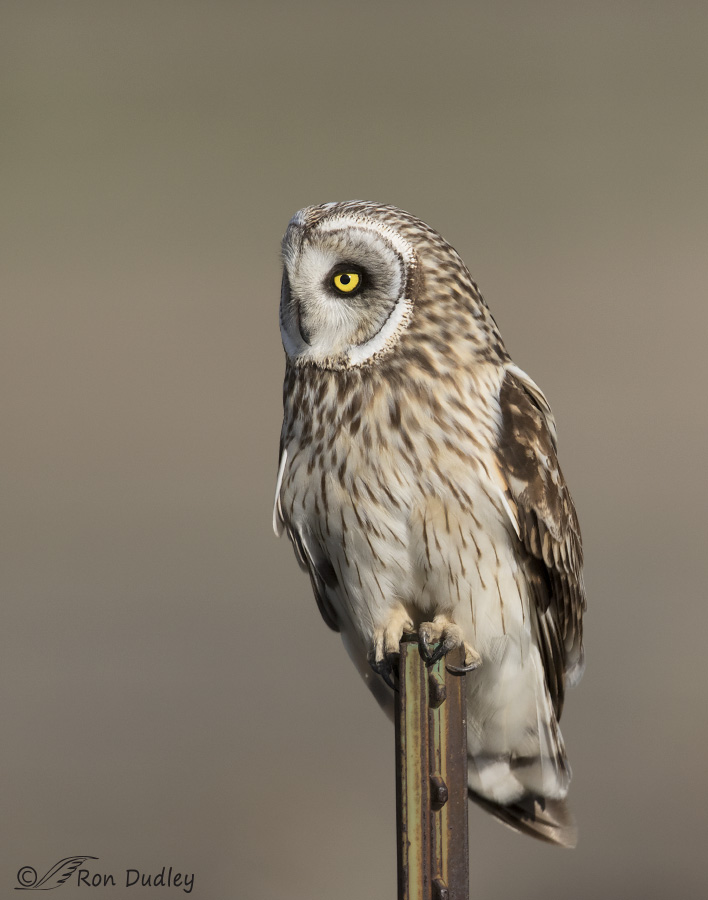 1/8000, f/5.6, ISO 800, Canon 7D Mark II, Canon EF 500mm f/4L IS II USM + 1.4 tc, not baited, set up or called in
1/8000, f/5.6, ISO 800, Canon 7D Mark II, Canon EF 500mm f/4L IS II USM + 1.4 tc, not baited, set up or called in
This bird was hunting from a metal fence post that was very close to the road (and to me). I fired off a few quick frame-filling shots with my teleconverter attached (I should have changed my aperture for more depth of field) with the intention of removing my tc at the first opportunity. But the owl never gave me that chance.
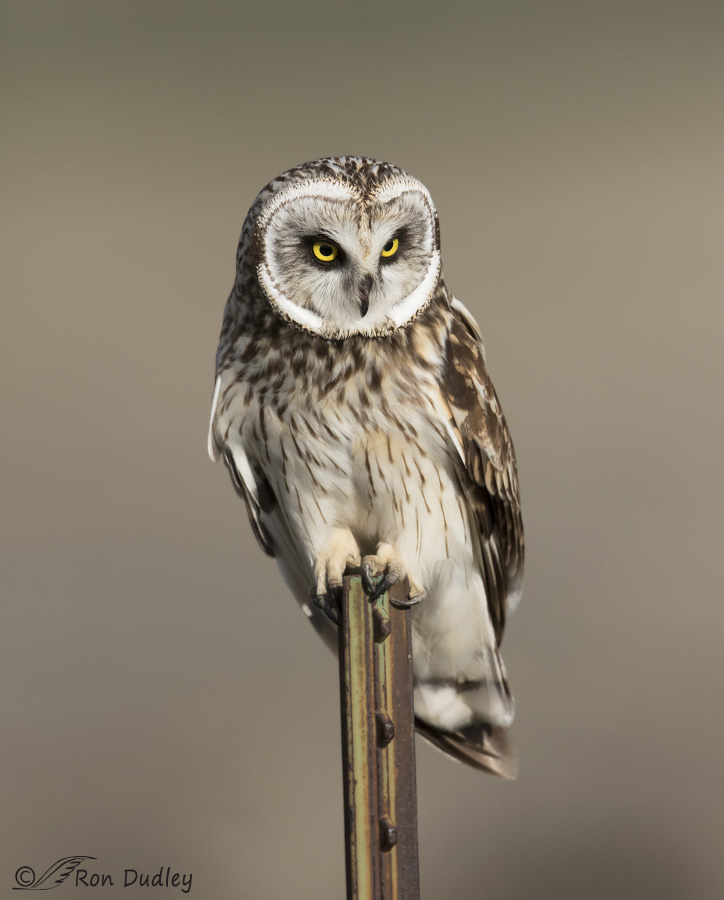 1/8000, f/5.6, ISO 800, Canon 7D Mark II, Canon EF 500mm f/4L IS II USM + 1.4 tc, not baited, set up or called in
1/8000, f/5.6, ISO 800, Canon 7D Mark II, Canon EF 500mm f/4L IS II USM + 1.4 tc, not baited, set up or called in
Almost immediately it began to focus intently on something in the grass between it and me. I was hesitant to remove my tc because I was afraid I’d miss the takeoff after prey while I was doing it but on the other hand I knew I’d clip or cut off wings if I didn’t. A dilemma…
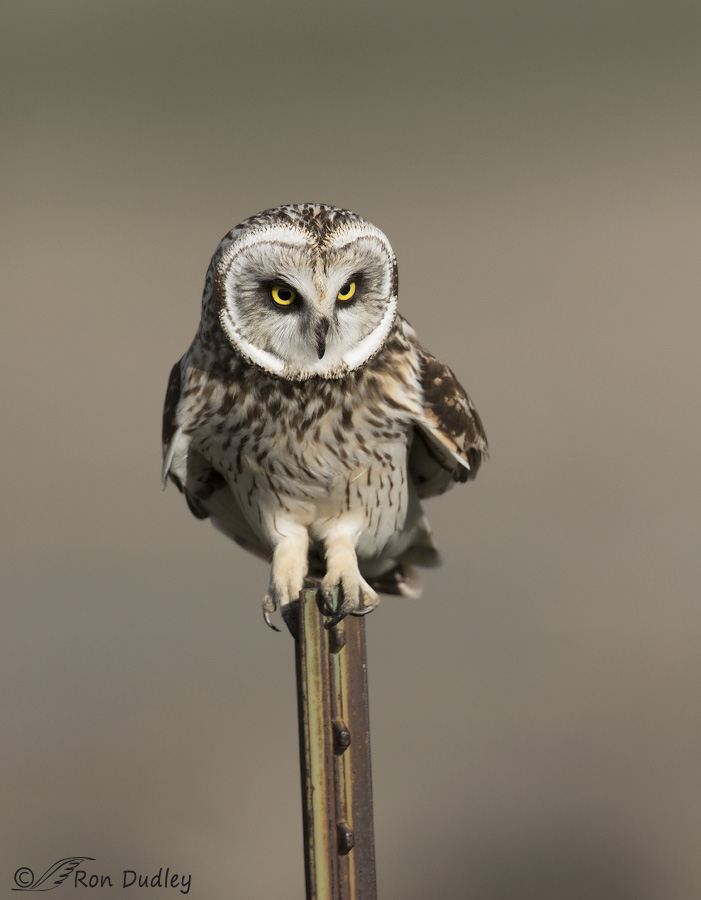 1/8000, f/5.6, ISO 800, Canon 7D Mark II, Canon EF 500mm f/4L IS II USM + 1.4 tc, not baited, set up or called in
1/8000, f/5.6, ISO 800, Canon 7D Mark II, Canon EF 500mm f/4L IS II USM + 1.4 tc, not baited, set up or called in
Several times the bird “twitched” like this, as if it was about to launch but each time it relaxed again and just watched that spot in the grass intently. The tension was truly palpable as I watched through the viewfinder with my finger on the “trigger”. I was probably doing a little twitching myself…
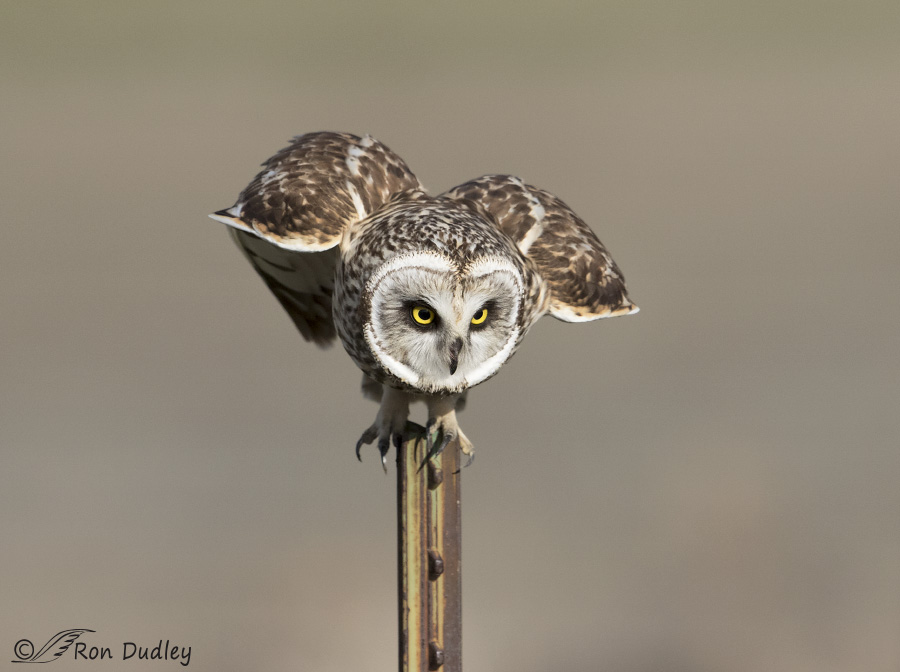 1/8000, f/5.6, ISO 800, Canon 7D Mark II, Canon EF 500mm f/4L IS II USM + 1.4 tc, not baited, set up or called in
1/8000, f/5.6, ISO 800, Canon 7D Mark II, Canon EF 500mm f/4L IS II USM + 1.4 tc, not baited, set up or called in
Finally the owl launched after the vole but as it took off I cut off wings…
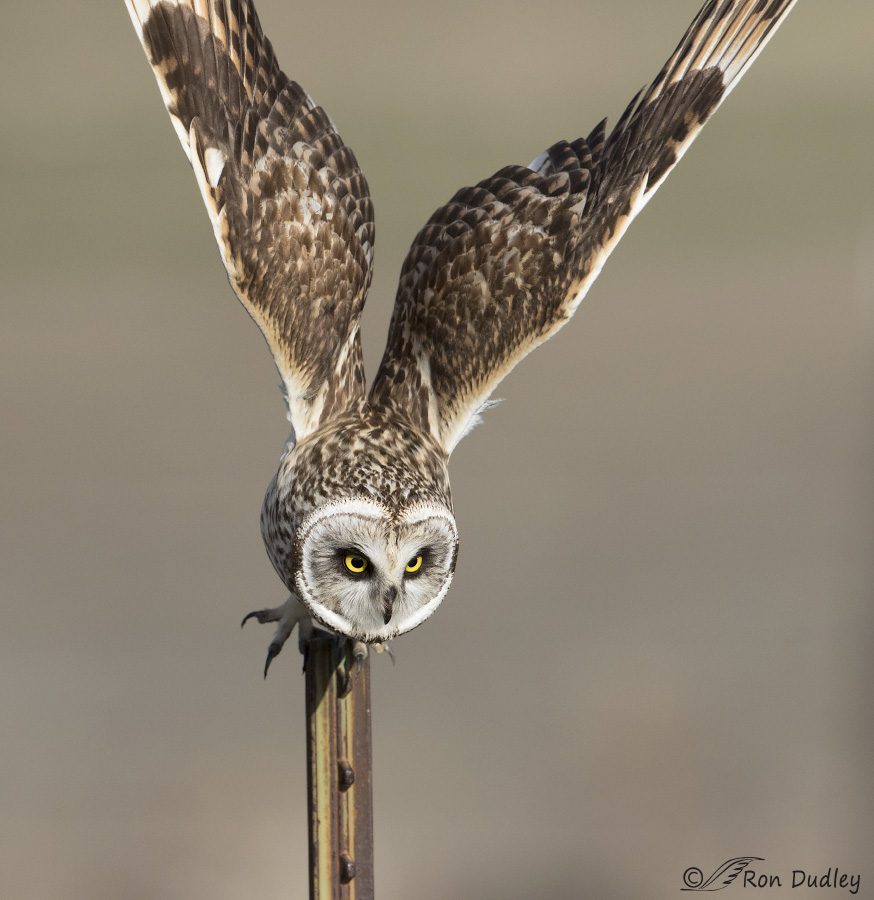 1/8000, f/5.6, ISO 800, Canon 7D Mark II, Canon EF 500mm f/4L IS II USM + 1.4 tc, not baited, set up or called in
1/8000, f/5.6, ISO 800, Canon 7D Mark II, Canon EF 500mm f/4L IS II USM + 1.4 tc, not baited, set up or called in
in every shot.
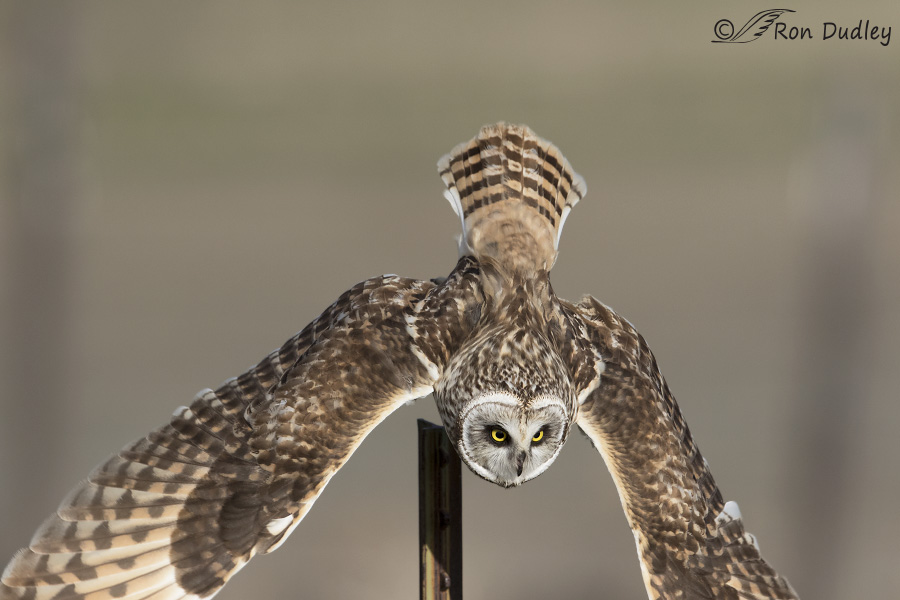 1/8000, f/5.6, ISO 800, Canon 7D Mark II, Canon EF 500mm f/4L IS II USM + 1.4 tc, not baited, set up or called in
1/8000, f/5.6, ISO 800, Canon 7D Mark II, Canon EF 500mm f/4L IS II USM + 1.4 tc, not baited, set up or called in
This is the one that really broke my heart. The owls I photographed that morning often took off at this interesting tail-up angle because their intended prey was so close to them as they hunted from the low posts.
The owl didn’t catch a vole on this attempt.
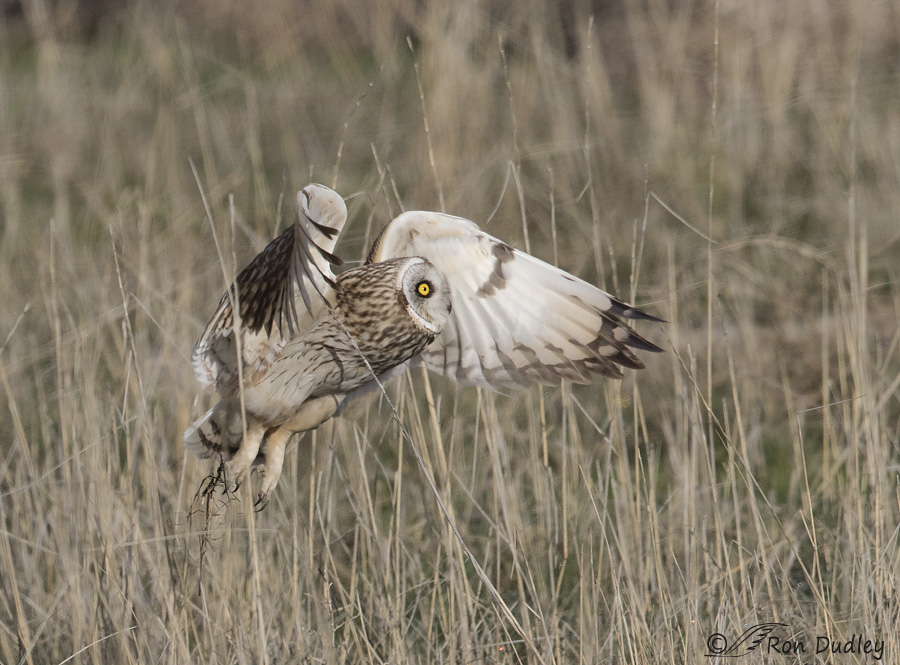 1/6400, f/6.3, ISO 800, Canon 7D Mark II, Canon EF 500mm f/4L IS II USM + 1.4 tc, not baited, set up or called in
1/6400, f/6.3, ISO 800, Canon 7D Mark II, Canon EF 500mm f/4L IS II USM + 1.4 tc, not baited, set up or called in
But six minutes later it tried again and though this attempt was also unsuccessful I was able to photograph it as it came up out of the grasses with only debris in its right foot.
On this morning I watched several owls dive on prey and each time they missed. In one study of hunting Short-eared Owls, “of 628 foraging attempts, 70.1% unsuccessful, 20.7% successful, and 8.1% unknown”.
That tells me that they typically have to work very hard for a meal.
Ron
On an unrelated note for aficionados of Antelope Island and its resident bison herd, the calves have arrived!
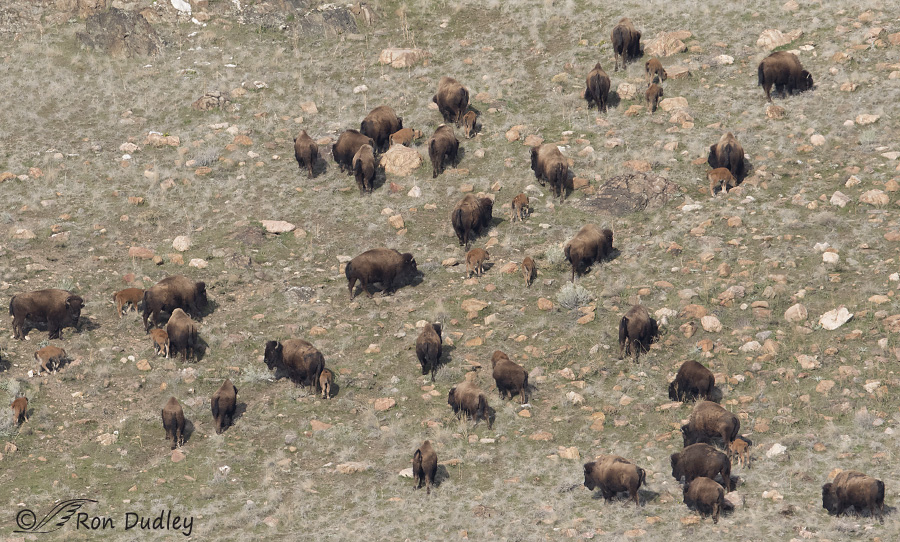
I photographed part of the herd yesterday morning from about 3/4 of a mile away and over a dozen very young calves can be seen in the image.
It’s amazing how different the behavior of the herd is when they have newborns. Normally these animals have no fear of vehicles or humans but as far away as these bison were, as soon as they saw my pickup they turned tail en masse and walked further away and higher up the mountain. I have no doubt that it was in reaction to my vehicle.


Excellent series, Ron. Exceptionally well done even by your high standards.
Nancy and I are participating in Short-eared Owl surveys this spring. We didn’t find any in two trips to Weiser Cove; we have hopes of the first trip to Camas Prairie this weekend.
Beautiful photos despite “clipped wings”. I love the intensity of the owls stare.
Perhaps the buffalo thought your silver pickup was the DNR checking on the calves.
In fact, for a change the success ratings go vole, Ron, owl. They are so often in a very different order.
Yeah, all to often I’m at the end of that list.
It least if the bird gets the vole there are two winners, potentially anyway…
While I feel your pain, the clipped wings add to the drama and the intensity.
And yes, of course you were all twitching. And only the vole got lucky.
Love the bison too.
Big, big smiles. Megathanks.
I really do twitch in situations like that, EC. Buck fever maybe…
Beautiful series, Ron. Never get tired of the intensity of the hunt!
And the hunt is just that, Diane – intense! Their concentration on it is truly impressive.
Incredible shots Ron. No apologies needed for clipping the wings as your shots are crispy tight!! When you can fill the frame, it makes for excellent pics. While I know you wanted to change the aperture, I didn’t see any issues with shooting wide open…tack sharp. The heart-break shot is just that…heart breaking. But as others have stated, if you took off the TC, it would’ve jumped and you would have missed it all. Quite simply, the best shorty pics I think I’ve ever seen.
Thanks very much, Zaph. I wanted more DOF for the first couple of images because the tail and wingtips aren’t sharp.
Really wonderful shots—-I am so glad you did not
change equipment —the intensity of the hunt is so much more apparent.
Agreed, Bobbi – there is that advantage of intimacy with very close shots of the action, even with body parts clipped or cut off. Thank you.
Wonderful shots, Ron, and I especially like shot #3 – Love the idea of you, the owl and the vole all twitching in these electric moments…
“Love the idea of you, the owl and the vole all twitching in these electric moments”
Loved that, Alison. That’s EXACTLY what happened and you put it so well!
What an outstanding series, even with the wing clips. And I’m sure you’d have missed the series entirely if you’d taken the time to change equipment. Birds, and nature in general, are like that. They don’t wait for us to get our stuff together. Insert my ridiculously redundant and repetitive OH WOW! here! I’ve found that parenthood is pretty darn universal, even in its diversity (bell curve paradigm).
I’ve found that parenthood is pretty darn universal, even in its diversity (bell curve paradigm).
Since Jack and I have concentrated on voles this year, I can tell you from first-hand experience that those little guys are HARD to catch. In their world, they have an extensive network of hidden pathways through the grasses/weeds. They’re only visible for about a nanosecond and then they disappear into that network–and they’re moving FAST. The raptor goes for where they were visible. And of course, like a race car driver heading directly for where the crash is when they first react to it, by the time they get there, the vole (crash scene) is off to some other (safer) where by the time they get there. That’s why the raptors’ success rate is so low with them. The good news is that when they DO catch one, it’s a nice-sized meal! A vole (or two) a day keeps the hunger away!
I’m also amazed at how raptors can perch on the smallest things like those metal fence posts. They just make it work.
Thanks so much for including the bison. With all the bison (and other critter) slaughter(s) going on, it’s good to see they can still thrive. And of course, when there are kids around, the parents are much more careful who’s where near the kiddos!
Thank you SO much. It’s such a delight to see your blog (near) first thing in the morning! Just THANKS!
Laura, you certainly have the elusive nature of voles pegged perfectly. I’ve been trying to get decent photos of them for years but when they do pop out into the open it’s only for a nanosecond – usually not enough time to get focused on them. I only have a few mediocre shots of voles.
Oh you CERTAINLY don’t have time to focus on voles. You don’t even have time to react and push the button when you see them! They’re invisible again long before you can react and act. Maybe you can talk Jack into waiting with one he’s caught–yeah, no, that’s not gonna work either
Your photos are incredibly beautiful and so inspiring!!!
Thanks very much, Bev.
What a wonderful series!!! Especially like the second (the angle of the body) and last two shots of the owl ( intensity of focus, detail, and tail-up view) and the overview of the bison herd…soooo good to see what appears to be healthy babies…(so sick,of wild things, open spaces being ruled by the cattle industry…a basically cruel, greedy, very unhealthy industry)…so hate me! It’s still true….and everyone knows it!!!
I’m glad you enjoyed the bison shot, Patty. I almost didn’t include it since it was so unrelated to the subject of the post.
Great shots…I enjoyed them all.
Thanks, Carol.
I’m with Dick on the WOW!!! factor. Great shots even with clipped wings. They must get a lot of nutrition from what they do catch with that kill rate! Bison photo with calves is also great. Have to hit Yellowstone Park here tho some of the reservations are getting some. Recently some brought down from Canada that are Brucellosis free – ranches REALLY get riled up about them for that and other reasons.
Great shots even with clipped wings. They must get a lot of nutrition from what they do catch with that kill rate! Bison photo with calves is also great. Have to hit Yellowstone Park here tho some of the reservations are getting some. Recently some brought down from Canada that are Brucellosis free – ranches REALLY get riled up about them for that and other reasons.
Judy, these bison (500-700 of them are rounded up annually in the fall and each animal is given a health check. It’s a well managed herd as far as I can tell.
Those incredible eyes! You captured them beautifully Ron.
Thank you, Anne.
WOW, WOW, WOW!!!!
Magnificent! These Short-eared Owl shots are fantastic! Great views, great portraits!
And, a big thank you for adding the herd of American Bison that have recently calved. All those calves look good for the herd, must be a healthy heard.
Are there any problems for the calves, e.g. predators that will try and take a calf? No wolves in this area, just coyotes?
Lovely series Ron, many thanks.
The herd is healthy and well managed, Dick. Nope, no wolves in the area and the coyotes are no real threat to any of them except young calves. Coyotes often walk within a few feet of the adults but the bison just ignore them.
I guess some different from Yellowstone?
Wonderful shots Ron!
Charlotte
Thanks, Charlotte.